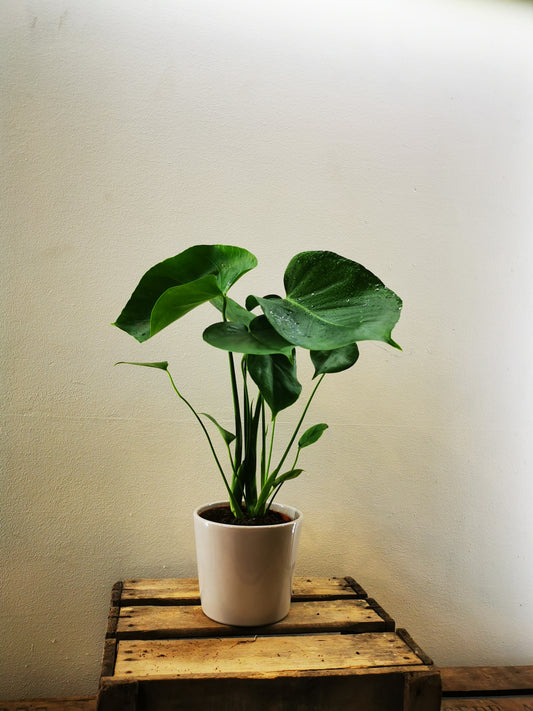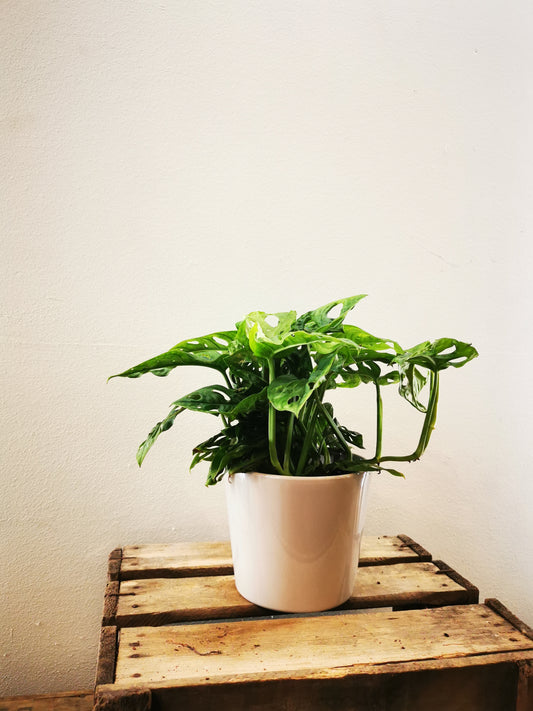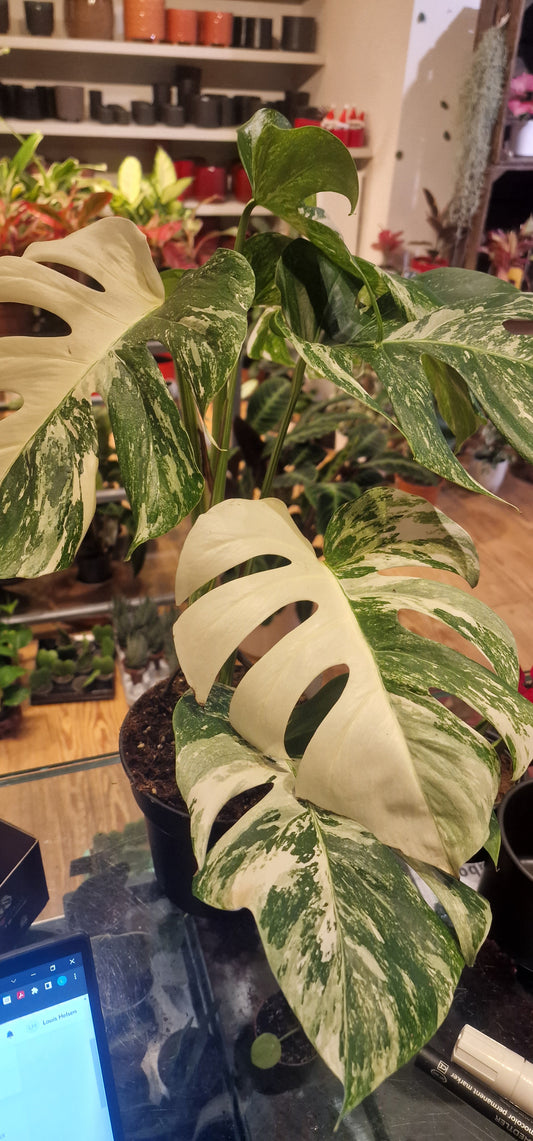
Caring for the Monstera deliciosa (Swiss cheese plant)?
Share
Welcome to our blog about the Monstera deliciosa, also known as the Swiss cheese plant. This impressive tropical plant is native to the rainforests of Central and South America, where it grows as a vine on the trunks of tall trees. Its glossy, pointed leaves and unusual aerial roots have made it a popular choice as a houseplant around the world.
The Monstera deliciosa is a fairly slow growing plant that can have an impressive look if given the right conditions. One of those impressive features are the fenestrations or 'holes' in the plant.
In this blog we will explore different aspects of the Monstera deliciosa, from its geography to its care and maintenance as a houseplant.
We will also delve deeper into the different types of Monstera and how to distinguish them. Whether you are an experienced plant lover or a beginner looking to add some greenery to your home, this blog has plenty of interesting things for you. Enjoy reading!
Where does the Monstera grow?
The Monstera deliciosa is native to a wide range of countries in Central and South America, including Mexico, Costa Rica, Panama, Colombia, Ecuador, Peru, and Brazil. It is also found in other parts of the world, such as Southeast Asia and the West Indies, where it has been introduced as an ornamental plant. The monstera thus comes from a tropical climate, where it is humid and warm.What types of Monstera are there?
There are several types of Monstera, including:
- the Monstera adansonii
- the Monstera Minima
- the Monstera Monkey Mask
- the Monstera Dubia
- the Monstera deliciosa Variegata
Each species has its own unique characteristics, such as leaf shape, size, and color. Whether you’re a seasoned plant lover or a novice looking to add a little greenery to your home, there’s a Monstera species for you. Want to learn how to identify Monsteras? You can learn here.
Caring for the Monstera
How much light does a Monstera need? 
The Monstera is a low light plant that thrives in bright, indirect light, such as that filtered through a window or sheer curtain. The ideal lighting conditions for a Monstera will depend on the specific location and orientation of your home or office, and may need to be adjusted based on the intensity and duration of light the plant receives. Understanding your Monstera’s lighting needs will help you provide the best possible care and support its growth and development.
A monstera rarely receives direct sunlight in nature, which can burn its leaves. So be careful with a strong sun behind glass!
Want to know more about the light needs of a Monstera ?
How much water do I give the Monstera Deliciosa?
The Monstera is a tropical plant that prefers to be kept constantly moist, but not wet. To determine your plant's water needs, check the moisture level in the soil and use lukewarm water to water the plant thoroughly.Lukewarm water prevents cold shock - which is not good for the plant.
Want to know more about watering the Monstera ?
Tips for caring for the Monstera
What to do with your aerial root 
The Monstera’s aerial roots perform a number of important functions and can be allowed to grow freely and naturally or encouraged to grow downwards and into the ground. To support the growth of the aerial roots, provide the plant with a support structure and keep moisture levels in mind to prevent rot. You can also easily roll up the roots and tuck them away in a decorative pot so that they are not too noticeable. We personally are big fans of this feature of the plant. It shows where it really comes from.Want to know more about what you can do with your aerial roots?
Put the Monstera on a moss stick
Before we dive into the details of attaching, it’s important to understand that this process works best when the plant is young and hasn’t developed a woody stem yet. If your Monstera is mature, it may be more difficult to attach it to a moss pole.You will find everything about how to attach a monstera to a moss stick in this blog.
The Monstera cuttings
Taking a cutting from a Monstera ? That's pretty easy! In this blog you will find all the information you need to successfully take cuttings from your Monstera ! We will talk about where to cut your Monstera, when the cutting can go in soil and if the Monstera cutting can also go in water!What is a Monstera Variegata?
Before we go into Monstera Variegata , it is important to understand what variegation actually is. Variegation (or albication), means that the plant has colored parts. These colors are caused by the - sometimes temporary - shortage of chlorophyll. This can lead to white, beige, light green or yellow spots on the plant. Variegation is often indicated in the plant name by the abbreviation var. that is used.Variegation is therefore caused by the absence of chlorophyll, the same substance that is responsible for the photosynthesis that a plant does. A plant that has 100% variegation, cannot live. There are plants that have completely white leaves, these plants also do not contribute to the photosynthesis of the plant. A not unimportant fact! These leaves are therefore a 'burden' for the plant, since they yield nothing apart from evaporation.
Variegata occurs in nature, such as in the Pothos Marble Queen or the Calathea White fusion . But in some plants a genetic mutation occurs. A kind of 'accident' of nature, such as in the Monstera deliciosa.
So this plant is rare rather than common and that makes it so special!
How do you care for a Monstera Variegata?
A Monstera Variegata can be cared for quite similarly to a normal - non variegata Monstera. The main differences are that the variegated leaves should not be in direct sunlight. Due to the absence of chlorophyll, the leaf burns almost immediately. In addition, the same care applies as for a normal Monstera.
Why does a Monstera Variegata cost more?
It's very simple: there are fewer Monstera Variegata's than there are Monsteras. The number is limited and collectors are eager to add them to their collection. You can buy or order a Monstera Variegata from us, and we will deliver it to you as soon as one is available.Order your Monstera Variegata here .
Common Monstera Problems
Help! There are thrips on my Monstera!
Thrips are small, slender insects that can be a big problem for plants, including Monsteras. These insects feed on the sap of plants and can cause damage to the leaves, flowers, and fruits of the plant. If you notice that your Monstera plant has thrips, it is important to take action as soon as possible to remove them.Want to know more about thrips on your Monstera?
My Monstera has no holes
If you have a Monstera plant, chances are you’ve noticed the familiar pattern of holes, or fenestrations, on the plant’s leaves. It’s one of the hallmarks of this unique tropical plant, and can add to its appeal. But not all Monstera plants have them, which sometimes raises questions about the plant’s health and well-being. How does this happen, and how do you fix it?Monstera gets yellow leaves
Soon to come!
My Monstera has brown spots
Soon to come!






